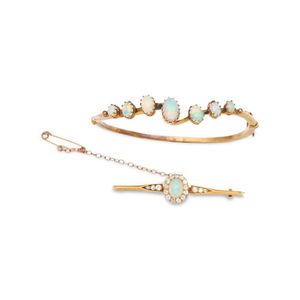Opal and Diamond Brooch and Bangle Set by F. Hyams
An opal and diamond brooch by Frank Hyams, circa 1900, together with an opal bangle, the brooch set to the centre with an oval white opal measuring approximately 8.12 x 6.03 x 3.14 mmm, framed and flanked with old European-cut diamonds; the hinged bangle set with a graduated row of oval white opals, the centre opal measuring 8.40 x 6.28 mm, the brooch signed F. Hyams, estimated total diamond weight 0.45 carats, mounted in 14ct gold, brooch length 5.4 cm, bangle inner circumference 17 cm.
You must be a subscriber, and be logged in to view price and dealer details.
Subscribe Now to view actual auction price for this item
When you subscribe, you have the option of setting the currency in which to display prices to $Au, $US, $NZ or Stg.
This item has been sold, and the description, image and price are for reference purposes only.
- Frank Hyams Ltd. - Frank Hyams purchased a jewellery business in Princess Street Dunedin in 1885. As well as a manufacturing jeweller, he was a silversmith and goldsmith and specialised in jewellery incorporating New Zealand greenstone. At the New Zealand and South Seas Exhibition in 1890 he secured "first order of merit" for the manufacture of gold, gem and greenstone jewellery.
Concurrent with his Dunedin store, in 1902 Frank Hyams registered a limited company, Frank Hyams Ltd., and established a business in London, at 167 New Bond Street, and later at 128 New Bond Street, London, trading as 'artistic jewellers, gold and silversmiths, and dealers in gems of rarity'.
Frank Hyams established a reputation within the English aristocratic and upper class social circles for his unique one-off curiosity pieces incorporating materials and design influences from his New Zealand homeland.
The British Museum has a collection of 36 badges manufactured by Frank Hyams Ltd., circa 1906.
According to the London Gazette, in 1913 at an Extraordinary General Meeting it was voted that the company be voluntarily wound up and Frank Hyams was appointed liquidator. - Circa - A Latin term meaning 'about', often used in the antique trade to give an approximate date for the piece, usually considered to be five years on either side of the circa year. Thus, circa 1900 means the piece was made about 1900, probably between 1895 and 1905. The expression is sometimes abbreviated to c.1900.
This item has been included into following indexes:
